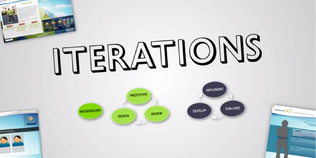Blog
3 Steps to Get MORE out of Subject Matter Expert (SME) Interviews
by Linda Rening, PhD - studio executive


e-Learning for Drama Queens (and Kings)
By Linda Rening | November 29, 2012 | Custom Learning | 0 Comments
 by Linda Rening, PhD - studio executive
by Linda Rening, PhD - studio executive
Who designs learning in your organization? Who decides how e-learning courses will look, and how learners will navigate through them? Is it you? Are you sure?
Can you tell who’s playing the lead in this dialog:
SME
(leaning forward; insistent)
We just need to get the
information out there –
it doesn’t have to look fancy.
Learning and Development
Associate
(rolling eyes; resigned)
Sigh.
Subject Matter Experts are just that: Experts on a particular topic. They know their subject matter inside and out. But, is their subject matter expertise learning design? Probably not. And with that, ladies and gentlemen, the drama begins.
Let’s try a different approach to the scene, starting with a different premise: e-Learning is not a linear progression through a series of slides. Rather, e-learning is an immersive experience that enables learners to be successful with new behaviors.
In one of Dr. Michael Allen’s recent books, Successful e-Learning Interface, Dr. Allen differentiates User Interface from Learner Interface:
User interface minimizes the attention and effort learners have to devote to working the computer. Learner interface design, however, maximizes the learning experience.
It is learner interface design that too often gets lost in e-learning, especially when we follow “the rules” about how e-learning should be structured. What we’ve been told may be different than what’s true:
- What we’ve been told: Placement of buttons like Next and Back needs to remain constant.
What’s true: The Next button can be anywhere – or nowhere – on the page, and could be called: Continue, Learn More, or Proceed Happily Forward.
- What we’ve been told: A Glossary and Resources should always be available.
What’s true: If learners know all the words and know where to find more information, they really don’t need a Glossary and Resources, do they?
- What we’ve been told: The company logo should appear on every page
What’s true: If someone doesn’t know where he works, send the poor guy home… speak in soothing tones… call a cab…
What if we threw out the rules and designed learning based on the needs of a specific group of learners who needed to master well-defined behaviors?
.jpg.jpeg?width=350&height=233&name=112812_elearning_for_drama_queens_(and_kings).jpg.jpeg)
Dr. Allen recommends creating an interface that is true to the actual context in which the learner will be asked to perform. Ethan Edwards recommends considering e-learning more in terms of a stage production than a classroom training class. Take a minute and think about that: You’re not writing a training class, you’re creating a Broadway play or a Hollywood movie. That frame of mind changes everything!
In your new role as Director, try to design learning as if the camera were on the learner’s shoulder. If the desired behavior takes place in a truck, the interface should be the dashboard of a truck. If the behavior takes place in interactions with customers, the interface should show a customer with whom the learner has a conversation. Taking that perspective, you can design e-learning to present challenges to the learner, and to provide contextually-accurate feedback based on the actions a learner takes.
When you’re designing, questions to ask yourself might be:
- What’s happening in front of the learner when he or she is performing the new desired behaviors?
- If the learner is the protagonist – the hero – of the story, what obstacles will he or she face in performing the new behavior?
- Where’s the drama? What elicits anxiety or passion for the learner?
In reality, there are only a few things we can do with a computer: click, drag, hover, and type. But with those few actions, and the right sense of drama, we can create magic.
.png?width=135&height=135&name=linda(250).png)
About the Author: Linda Rening
Comments
Would you like to leave a comment?
Related Blog Posts
.png?width=316&name=mellas%2c_nicole(200).png)
By: Linda Rening | Mar, 2014
Category: Custom Learning

Blog
Iterations: The Role of a SME in an Instructional Design Project
by Linda Rening, PhD - studio executive
By: Linda Rening | Mar, 2013
Category: Custom Learning

Blog
5 Reasons Why Game-Based Learning Should Matter to Organizations
by Linda Rening, PhD - studio executive
By: Linda Rening | Jul, 2015
Category: Custom Learning
